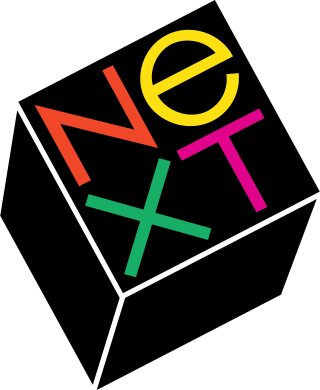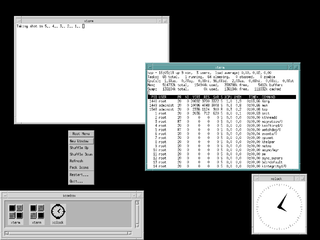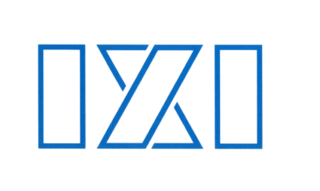Related Research Articles

Digital Equipment Corporation, using the trademark Digital, was a major American company in the computer industry from the 1960s to the 1990s. The company was co-founded by Ken Olsen and Harlan Anderson in 1957. Olsen was president until he was forced to resign in 1992, after the company had gone into precipitous decline.

A graphical user interface, or GUI, is a form of user interface that allows users to interact with electronic devices through graphical icons and visual indicators such as secondary notation. In many applications, GUIs are used instead of text-based UIs, which are based on typed command labels or text navigation. GUIs were introduced in reaction to the perceived steep learning curve of command-line interfaces (CLIs), which require commands to be typed on a computer keyboard.

The history of the graphical user interface, understood as the use of graphic icons and a pointing device to control a computer, covers a five-decade span of incremental refinements, built on some constant core principles. Several vendors have created their own windowing systems based on independent code, but with basic elements in common that define the WIMP "window, icon, menu and pointing device" paradigm.

In computer networking, a thin client is a simple (low-performance) computer that has been optimized for establishing a remote connection with a server-based computing environment. They are sometimes known as network computers, or in their simplest form as zero clients. The server does most of the work, which can include launching software programs, performing calculations, and storing data. This contrasts with a rich client or a conventional personal computer; the former is also intended for working in a client–server model but has significant local processing power, while the latter aims to perform its function mostly locally.

The X Window System is a windowing system for bitmap displays, common on Unix-like operating systems.

OpenStep is an object-oriented application programming interface (API) specification developed by NeXT. It provides a framework for building graphical user interfaces (GUIs) and developing software applications. OpenStep was designed to be platform-independent, allowing developers to write code that could run on multiple operating systems, including NeXTSTEP, Windows NT, and various Unix-based systems. It has influenced the development of other GUI frameworks, such as Cocoa for macOS and GNUstep.

A terminal emulator, or terminal application, is a computer program that emulates a video terminal within some other display architecture. Though typically synonymous with a shell or text terminal, the term terminal covers all remote terminals, including graphical interfaces. A terminal emulator inside a graphical user interface is often called a terminal window.

In computing, Motif refers to both a graphical user interface (GUI) specification and the widget toolkit for building applications that follow that specification under the X Window System on Unix and Unix-like operating systems. The Motif look and feel is distinguished by its use of rudimentary square and chiseled three-dimensional effects for its various user interface elements.

A/UX is a Unix-based operating system from Apple Computer for Macintosh computers, integrated with System 7's graphical interface and application compatibility. It is Apple's first official Unix-based operating system, launched in 1988 and discontinued in 1995 with version 3.1.1. A/UX requires select 68k-based Macintosh models with an FPU and a paged memory management unit (PMMU), including the Macintosh II, SE/30, Quadra, and Centris series.

A computer terminal is an electronic or electromechanical hardware device that can be used for entering data into, and transcribing data from, a computer or a computing system. The teletype was an example of an early-day hard-copy terminal and predated the use of a computer screen by decades. Starting in the mid-1970s with machines such as the Sphere 1, Sol-20, and Apple I, terminal circuitry began to be integrated into personal and workstation computer systems, with the computer handling character generation and outputting to a CRT display such as a computer monitor or, sometimes, a consumer TV.

OPEN LOOK is a graphical user interface (GUI) specification for UNIX workstations. It was originally defined in the late 1980s by Sun Microsystems and AT&T Corporation.

The Santa Cruz Operation, Inc. was an American software company, based in Santa Cruz, California, that was best known for selling three Unix operating system variants for Intel x86 processors: Xenix, SCO UNIX, and UnixWare.

In computing, text-based user interfaces (TUI), is a retronym describing a type of user interface (UI) common as an early form of human–computer interaction, before the advent of bitmapped displays and modern conventional graphical user interfaces (GUIs). Like modern GUIs, they can use the entire screen area and may accept mouse and other inputs. They may also use color and often structure the display using box-drawing characters such as ┌ and ╣. The modern context of use is usually a terminal emulator.

The Bloomberg Terminal is a computer software system provided by the financial data vendor Bloomberg L.P. that enables professionals in the financial service sector and other industries to access Bloomberg Professional Services through which users can monitor and analyze real-time financial market data and place trades on the electronic trading platform. It was developed by employees working for businessman Michael Bloomberg. The system also provides news, price quotes, and messaging across its proprietary secure network. It is well known among the financial community for its black interface, which has become a recognizable trait of the service. The first version of the terminal was released in December 1982.

IXI Limited was a British software company that developed and marketed windowing products for Unix, supporting all the popular Unix platforms of the time. Founded in 1987, it was based in Cambridge. The product it was most known for was X.desktop, a desktop environment graphical user interface built on the X Window System. IXI was acquired by the Santa Cruz Operation (SCO) in February 1993.

Windows NT 3.1 is the first major release of the Windows NT operating system developed by Microsoft, released on July 27, 1993.

SlipKnot was one of the earliest World Wide Web browsers, available to Microsoft Windows users between November 1994 and January 1998. It was created by Peter Brooks of MicroMind, Inc. to provide a fully graphical view of the web for users without a SLIP or other TCP/IP connection to the net, hence the name – SLIP...not. SlipKnot provided a graphical web experience through what would otherwise be a text-only Unix shell account. SlipKnot version 1.0 was released on November 22, 1994, approximately 3 weeks before Netscape's Netscape Navigator version 1.0 came out. It was designed to serve a significant fraction of PC/Windows-based Internet users who could not use Mosaic or Netscape at that time.
ND-NOTIS was a office automation suite by Norsk Data introduced in the early 80s, running on the SINTRAN III platform on both ND-100 and ND-500 architectures. It was also available on Microsoft Windows running in networks of Norsk Data servers.

The Common Open Software Environment (COSE) was an initiative formed in March 1993 by the major Unix vendors of the time to create open, unified operating system (OS) standards.
NetManage Inc. was a software company based in Cupertino, California, founded in 1990 by Zvi Alon, an Israeli engineer. The company's development centre was located at the MATAM technology park, in Haifa, Israel. In June 2008 the company was acquired by Micro Focus International, a British company based in Newbury, Berkshire.
References
- 1 2 3 Richard Shuford (ed.). ""Alphawindows" -- a windowing setup for character-cell video terminals". Archived from the original on 2008-10-07. Retrieved 2007-09-22.
- ↑ Information Technology Standards Guidance — User Interface Services. Vol. 3 of 14. U. S. Department of Defense. April 7, 1997.
- 1 2 "First AlphaWindows Character-Based Terminals Set For To Appear in May, At From $600..." CBRonline.com. 1992-02-14.
- ↑ New Products (July–August 1992). "Cumulus Technology Announces Support for New AlphaWindow Standard". Sys Admin Magazine. Archived from the original on 2011-07-23. Retrieved 2007-09-22.
- 1 2 "Microvitec First Past Post in Europe with AlphaWindows Terminals; IBM OEM Pact in Prospect..." CBRonline.com. 1992-08-12.
- ↑ Brad Myers (March 1995). "User Interface Software Tools".
- ↑ "Cumulus Technology Wins Contract from Unisys". CBRonline.com. 1988-01-18.
- 1 2 "Company Summary — Cumulus Technology Ltd". March 1994.
- ↑ David Kallman (1997-05-21). "Did Cumulus drop off the face of the earth, again?? (HP3000-L mailing list comment)".
- ↑ Henry Keultjes (2005-05-04). "Small Box 'To End Digital Divide' (InterLUG mailing list comment)".
- ↑ Tim Parker (March 1999). "MultiView v. 4 — Breathing new life into old character-based UNIX applications is easier with MultiView". Unix Review.
- ↑ "JSB reports record revenues increase". E-consultancy. 2000-07-05.[ permanent dead link ]
- ↑ "SurfControl sells off MultiView". E-consultancy. 2001-02-19.[ permanent dead link ]
- ↑ "Structured Software Solutions, Inc. Again Named to Fast Tech 50". FacetCorp. May 1996. Archived from the original on 2008-05-11. Retrieved 2007-09-28.